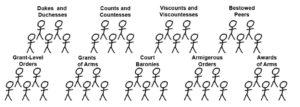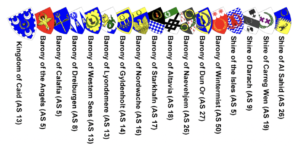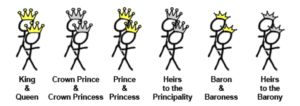How Order of Precedence Works
The most common question an Order of Precedence clerk receives is some variation of “How does precedence order work?” This can be answered in two ways. The first is a detailed breakdown of the back-end formulas and coding that will make most people glaze over. The second is a more approachable plain-language overview of the ideas that guide precedence order. It is the latter option that I hope to provide to you, the reader, in this article.
Oh, and there will be pictures.
What is the order of precedence?
There are two answers to this question. First, the (capitalized) Order of Precedence (hereafter exclusively referred to as the OP) is a record of awards and honors bestowed in the SCA. OP databases are maintained by each kingdom, but records will frequently overlap when a person moves from one kingdom to another. Each kingdom has its own policies about what does and doesn’t appear in their OP, but all kingdoms track those awards which convey rank (awards/grants of arms, awards and order memberships which carry with them awards or grants of arms, court baronies, peerage orders, and royal peerages).
The (uncapitalized) order of precedence is a list of people, roles, or territories, organized by the rank they hold in the SCA. For individuals, placement in the order of precedence relies on the information contained in the OP. For territories, placement usually involves the date of establishment of said territory at its level. More on that later; for the moment, we will focus on individuals.
How is an individual placed in the order of precedence?
Organizing an order of precedence starts with dividing the populace into groups. In Caid, these groups are, in descending rank order:
- Dukes and Duchesses
- Counts and Countesses
- Viscounts and Viscountesses
- Bestowed Peers (Chivalry, Laurel, Pelican, Defense)
- Grant-Level Order Members (Crescent, Lux Caidis, Gauntlet, White Scarf, Chiron, Golden Lance, Argent Blade)
- Grant-Bearers (bare grant of arms (GoA))
- Court Barons and Court Baronesses
- Armigerous-Level Order Members (Dolphin, Harp Argent, Crescent Sword, Duellist, Argent Arrow, Chamfron)
- Armigers (bare award of arms (AoA))
If an individual holds multiple awards across different levels, they are placed into the highest level for which they have an award. So someone with an AoA, a Dolphin, and a Crescent would be placed into the Grant-bearing Order group. Those who do not have any awards, or who hold only awards which carry no rank, are excluded from the order of precedence.

Within each group, gentles are organized by the date they attained that rank. A Duchess elevated in AS 5 outranks a Duke elevated in AS 6, a Pelican elevated in AS 37 outranks a Knight elevated in AS 48, and so forth. If two people attained the new rank on the same day (e.g. a Count and Countess), they are organized in alphabetical order by first name.

Once all of the groups are separated and organized, individuals are assigned a number, counting off from highest to lowest and continuing seamlessly from one group to the next. If there are 16 Dukes and Duchesses, they will be numbered 1-16, and the first Count or Countess in the next tier will be numbered 17. This final numbered list is the order of precedence, and an individual’s assigned number in that list is their precedence number. (Note: not all kingdoms assign or publicly report this number.)

Wait… A grant of arms outranks a court barony?
By default, yes! Corpora requires that court baronies carry at least an award of arms, though kingdoms have the option to have them carry more. Most kingdoms, if they want to have a court barony carry a grant of arms, will bestow a grant of arms separately at the same time as the court barony; Caid has no such tradition. So although court barons and baronesses wear a coronet which carries great prestige, and though they frequently hold awards which place them higher in the order of precedence, the coronet itself only places the bearer above the armigerous orders.
What happens when someone gets a new award?
It depends on whether it moves them into a new precedence group. If a Companion of the Dolphin is admitted to the Order of the Harp Argent, she stays in the same group and in the same place in the order. If a Companion of the Dolphin is admitted to the Order of the Crescent, she jumps to the end of the Grant-bearing Orders group and gets a new number one greater than the person who joined the group just before her.

At the same time, the number of everyone she just jumped increases by one. Because of this, your precedence number is almost always going to increase. The higher you go in rank, the less often your rank will change, but unless you are the first Duke or Duchess in the SCA (Fulk de Wyvern and Mary of Tamar), there’s always a possibility that someone may move into the kingdom, or be elevated within the kingdom, with a higher rank than you, thus increasing your precedence number.
When does order of precedence matter?
In most circumstances, the order of precedence doesn’t affect the day-to-day experience of the SCA. There are certain situations where it comes into play, most notably at Crown Tournaments and Queen’s Champion Tournaments when organizing the challenge rounds. And when certain peers argue about who should do the toast at a feast, the order of precedence is usually invoked.
At some point, the Crown might request a Grand March, a ceremony where everyone would process into court by order of precedence. Even many years ago, when there were fewer people in the SCA and such ceremonies were common, Grand Marches took a long time to coordinate and execute; these days, the amount of time and energy required to facilitate one is not typically considered worth the experience.
Note to newcomers: some may try to convince you that shower lines are organized by precedence. Do not believe them unless they are in a kingdom tabard with the Crown in attendance.
The other time that order of precedence matters is during court, particularly for Royal processions and placement of thrones on the dais. But it’s not individuals that matter there, so much as the heads of territories.
How do territories fit into the order of precedence?
You may have noticed that the order of precedence structure above does not include Kings and Queens, Princes and Princesses, or Territorial Barons and Baronesses. This is because the structure above deals only with permanent ranks. Each of the positions mentioned in this paragraph are not lifetime positions, but instead are to be passed from person to person at regular intervals.
Just as the order of precedence for individuals depends both on what ranking group they’re in and when they were elevated to that level, so too do territories (and their representatives) get placed in precedence order by the type of territory and when they were established at that level. The ranks of territories, in descending order, are:
- Kingdom
- Principality
- Barony/Province
- Shire
- Dependent Subgroup (Canton/College/Stronghold/Port/Riding)
Each of the 20 kingdoms derives its precedence from the date of its establishment as a kingdom. At the head of the kingdom list is the Kingdom of the West, founded in AS 1. At the end of that list (as of this writing) is the Kingdom of Avacal, founded in AS 50.
Principalities are ordered by the date of investiture of their first Prince and Princess. Baronies are ordered by the investiture of their first Baron and Baroness. Provinces and Shires are organized by the date they were established at their respective levels, as are dependent subgroups within those territories. Baronies and provinces rank equally with one another, followed by shires. Independent territories under the Crown of Caid are ordered as follows:

Each territory follows the same organizational principles as the individual order of precedence. However, within its own lands each territory takes top precedence among its class. For example, at an event held in the Barony of Lion’s Gate in the Principality of Tir Righ within the Kingdom of An Tir, the King of An Tir outranks the King of the West, the Prince of Tir Righ outranks the Princes of the Mists (West) and the Summits (An Tir), and the Baron of Lion’s Gate outranks all other territorial barons.
So how do the territorial ranks fit together with the permanent order of precedence?
Some kingdoms have rigid definitions of how Royalty and Landed Nobility fit within the permanent order of precedence for the duration of their tenure, while others (like Caid) consider the roles separately from the permanent ranks, if at all.
It is generally accepted that the King and Queen are at the top of the precedence order for their kingdom, with Crown Prince and Crown Princess below them, followed by Territorial Princes and Princesses (if any), Heirs to Principalities (if any), and Territorial Barons and Baronesses and their heirs (if any).

However, the relative rank and precedence order of, say, a Territorial Baron vs. a Duke is a matter for Inter-Kingdom Anthropology, and the answer is usually “it depends on the circumstances.”
In Caid’s Crown Tournament Lists, the role and authority of a Territorial Baron or Baroness is generally disregarded; within this context, the individual is an entrant in a tournament and not an agent of the Crown, so only their personal precedence order would be taken into consideration. However, if a Territorial Baron or Baroness is within their own Barony acting as Regent on behalf of the Crown, then within that context they would outrank any individual precedence order.
Some kingdoms also include Kingdom officers, ambassadors, and other people acting on behalf of the Crown into their role-based order of precedence. However, the varied practices are too numerous to go into any great detail here. Suffice to say that, should you be called upon to act as ambassador for your King and Queen in a foreign court, be sure to check with that court’s herald to find out where that places you on the pecking order. You may find yourself outranking the heirs to the realm, pressed into giving the toast at a Royal feast with five minutes notice!
The order of precedence is a useful tool to arrange people in an objective manner, paying respect to their rank and relative position in the kingdom. It helps dictate protocol and ceremony when needed, and prevents confusion and upset among the landed nobility.
